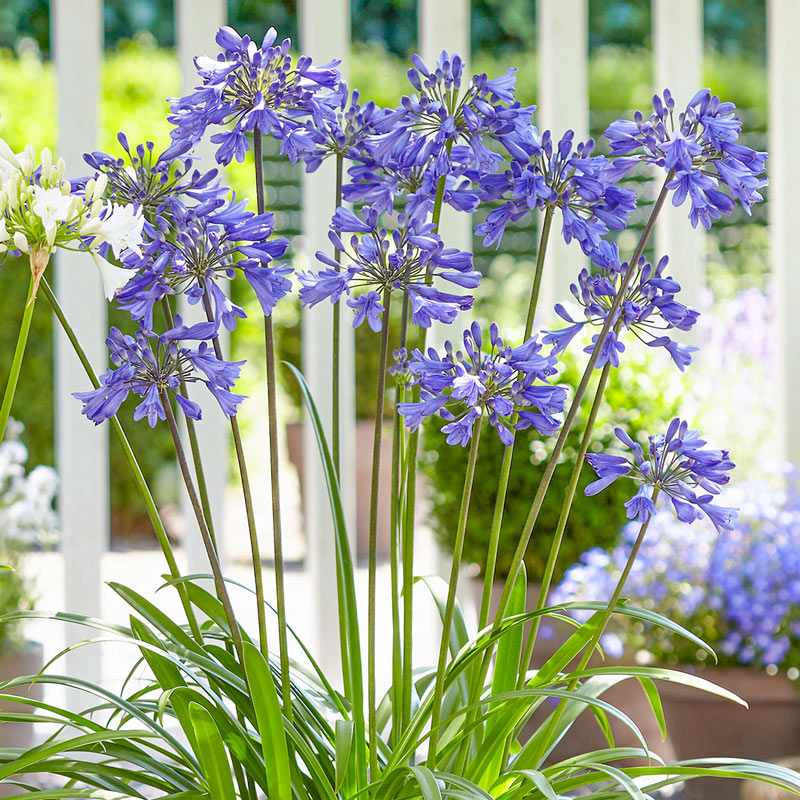Typical Agapanthus Problems and How to Solve Them
Typical Agapanthus Problems and How to Solve Them
Blog Article
Understanding the Art of Agapanthus Treatment: Vital Actions for Healthy And Balanced Development and Vibrant Flowers
In the realm of gardening, the growing of agapanthus stands as a rewarding venture for those who seek to support these sophisticated blooming plants. From selecting the best selection to understanding pruning methods, the journey in the direction of cultivating prospering agapanthus plants is diverse and holds the key to unlocking the full possibility of these herb treasures.
:max_bytes(150000):strip_icc()/agapanthus-growing-guide-7368912_06ba-bf1fa268243b451387986fbd1e2433b3.jpg)
Selecting the Right Agapanthus Variety

When picking the right Agapanthus range for your garden, consider aspects such as climate viability, flower color, and growth habit. Furthermore, think about the climate in your region to make sure the Agapanthus range you choose can thrive in your details conditions. Comprehending the growth habit of different Agapanthus ranges is critical for correct positioning within your yard.
Suitable Planting Problems
Considering the ideal environmental requirements is crucial for successful Agapanthus cultivation. Agapanthus flourishes in well-draining dirt with a slightly acidic to neutral pH level. When planting, pick an area that obtains complete sunlight to partial color. In hotter environments, offering some mid-day color can stop scorching of the leaves. Agapanthus plants are sensitive to cool temperature levels and need to be secured from frost during winter season.
To make sure healthy and balanced growth and dynamic flowers, plant Agapanthus light bulbs at a deepness of regarding 2-4 inches and room them 8-12 inches apart. Mulching around the base of the plants assists maintain wetness and reduces weed development.
Watering and Feeding Tips
Keeping appropriate wetness levels and offering necessary nutrients are crucial elements in the treatment program for Agapanthus plants. It is essential to strike a balance when it comes to sprinkling Agapanthus. If overwatered, these plants prefer regularly damp soil yet are prone to root rot. During the growing period, water deeply once a week, ensuring the dirt is well-draining to avoid waterlogging. In hotter environments or during durations of drought, even more frequent watering might be necessary to maintain the dirt evenly wet. However, reduce watering in the winter to avoid waterlogged conditions.
Fertilizing Agapanthus is essential for advertising healthy and balanced growth and respected blossoms. Apply a well balanced fertilizer, such as a 10-10-10 formula, in the early spring as brand-new development emerges. Repeat this hop over to these guys application every 6-8 weeks throughout the growing season. Avoid too much fertilization, as it can result in lavish vegetation at the cost of blossoms. Constantly adhere to the producer's guidelines for correct dilution and application techniques. By complying with these watering and fertilizing ideas, you can guarantee your Agapanthus plants prosper and generate lively, resilient blossoms.
Pruning Strategies for Agapanthus
Pruning Agapanthus plants at the appropriate times and with appropriate methods is essential for maintaining their wellness and promoting optimum development and blooming. The perfect time to trim Agapanthus is in late winter season or very early springtime prior to new growth arises.
Deadheading spent blossoms can also redirect the plant's energy into creating even more blooms rather than establishing seeds. If you want to accumulate seeds for breeding, leave some flowers to dry and mature on the plant.
Bear in mind to utilize tidy, sharp devices to make precise cuts and minimize the risk of introducing conditions. Agapanthus. Routine pruning will certainly aid keep your Agapanthus looking neat and healthy and balanced while making certain a plentiful display of lovely blossoms
Handling Usual Parasites and Conditions
After making sure appropriate pruning strategies for Agapanthus, it is crucial to attend to usual insects and conditions that can affect the health and wellness and vigor of these plants. One usual bug that impacts Agapanthus is the Agapanthus gall midget.
An additional typical problem is fungal fallen leave place, which offers as dark sores on the fallen leaves. To avoid fungal conditions, make sure great air flow around the plants, stay clear of above watering, and eliminate any contaminated fallen leaves quickly. In addition, Agapanthus plants can deal with origin rot if they are planted in improperly draining soil. To prevent this, plant Agapanthus in well-draining dirt and stay clear of overwatering. By being watchful and taking timely action against bugs and illness, you can help your Agapanthus plants grow and produce vibrant flowers.

Conclusion
Finally, grasping the art of agapanthus treatment entails picking the right selection, giving ideal planting conditions, proper watering and feeding, proper pruning methods, and resolving view it usual insects and illness. By complying with these important steps, you can ensure healthy growth and vivid blossoms for your agapanthus plants. Bear in mind to routinely check more and maintain your plants to advertise their total health and durability.
To ensure healthy development and dynamic blooms, plant Agapanthus light bulbs at a depth of concerning 2-4 inches and space them 8-12 inches apart. By following these watering and feeding suggestions, you can ensure your Agapanthus plants thrive and create vibrant, lasting blossoms.
One typical bug that affects Agapanthus is the Agapanthus gall midge. Furthermore, Agapanthus plants can suffer from root rot if they are grown in improperly draining pipes soil. By adhering to these vital actions, you can ensure healthy and balanced development and vibrant blossoms for your agapanthus plants.
Report this page